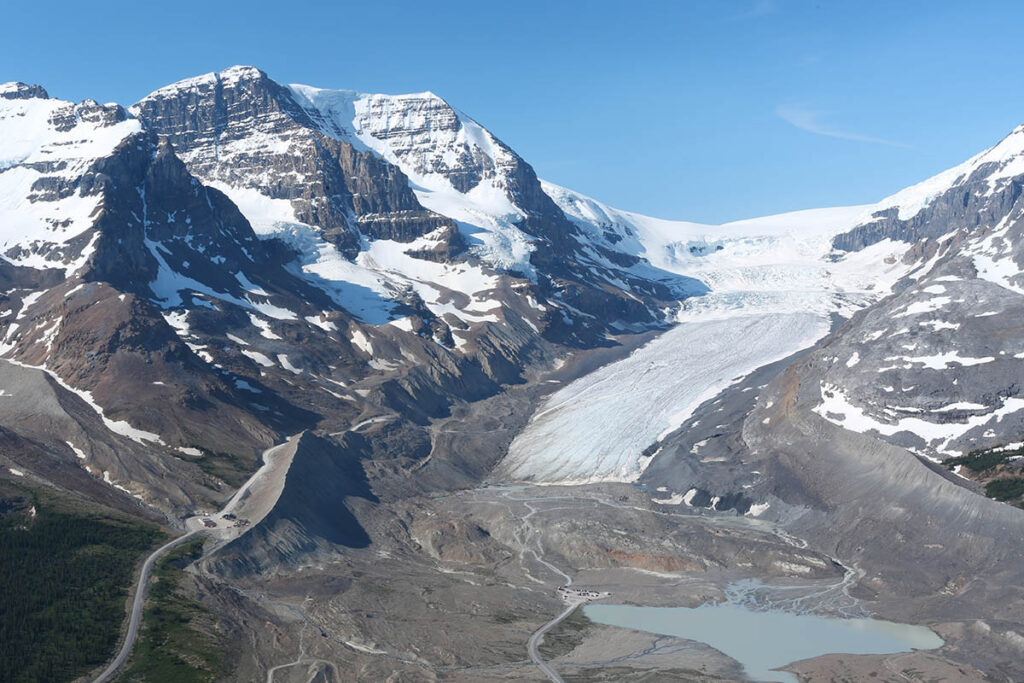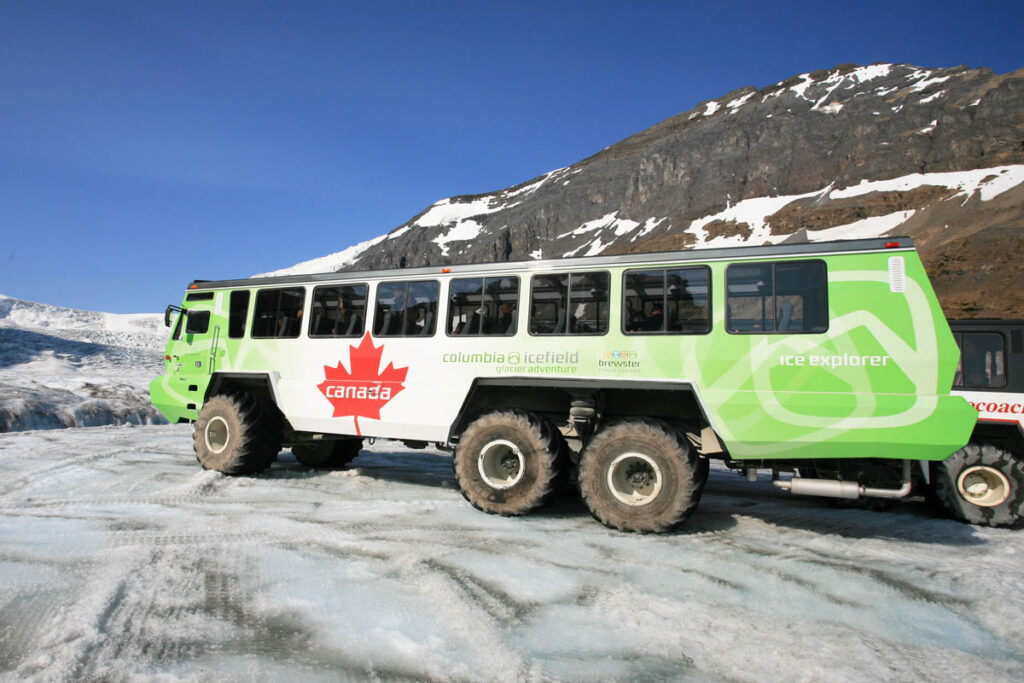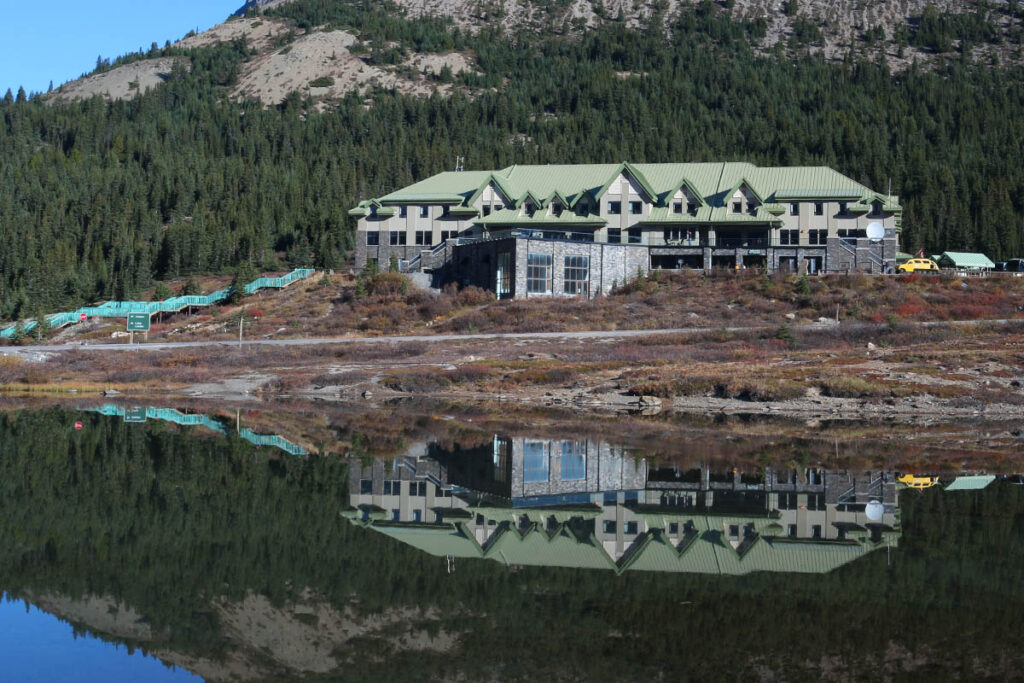Columbia Icefield
The largest and most accessible of 17 glacial areas along the Icefields Parkway is 325-square-kilometre (125-square-mile) Columbia Icefield, beside the Icefields Parkway at the south end of Jasper National Park, 105 kilometres (65 miles) south from Jasper and 132 kilometres (82 miles) north from Lake Louise. It’s a remnant of the last major glaciation that covered most of Canada 20,000 years ago, and it has survived because of its elevation at 1,900 to 2,800 metres (6,230 to 9,190 feet) above sea level, cold temperatures, and heavy snowfalls. From the main body of the ice cap, which sits astride the Continental Divide, six glaciers creep down three main valleys. Of these, ATHABASCA GLACIER is the most accessible and can be seen from the Icefields Parkway; it is one of the world’s few glaciers that you can drive right up to. It is an impressive 600 hectares (1,480 acres) in area and up to 100 metres (330 feet) deep. The speed at which glaciers advance and retreat varies with the long-term climate. Athabasca Glacier has retreated to its current position from across the highway, a distance of more than 1.6 kilometres (one mile) in a little more than 100 years. Currently it retreats up to two metres (six feet) per year. The rubble between the toe of Athabasca Glacier and the highway is a mixture of rock, sand, and gravel known as till, deposited by the glacier as it retreats.
The icefield is made more spectacular by the impressive peaks that surround it. Mount Athabasca (3,491 metres/11,450 feet) dominates the skyline, and three glaciers cling to its flanks. Dome Glacier is also visible from the highway; although part of Columbia Icefield, it is not actually connected. Instead, it is made of ice that breaks off the icefield 300 metres (980 feet) above, supplemented by large quantities of snow each winter.

Columbia Icefield from Wilcox Ridge.
Exploring the Columbia Icefield
Exploring the Columbia Icefield is easy on foot or on a bus tour. See Can you hike to the Columbia Icefield? For information on tours. From the Icefields Parkway, an unpaved road leads down through piles of till left by the retreating Athabasca Glacier to a parking area beside Sunwapta Lake. An interesting alternative is to leave your vehicle beside the highway and take the 1.6-kilometre (one-mile) hiking trail through the lunar-like landscape to the parking area. From this point, a short path leads up to the toe of the glacier. See Columbia Icefield Hiking. (Along the access road, look for the small markers showing how far the toe of the glacier reached in years past; the farthest marker is across the highway beside the stairs leading up to the Icefield Centre.)
Immediately north of Icefield Centre is an unheralded pullout where few travellers stop, but which allows for an excellent panorama of the area away from the crowds. Across the glacial-green Sunwapta River is a wasteland of till and a distinctive terminal moraine left behind by the retreating Dome Glacier. Between the Dome and Athabasca Glaciers is 3,459-metre (11,350-foot) Snow Dome.
Ice Explorer
The icefield can be dangerous for unprepared visitors. Like all glaciers, the broken surface of the Athabasca is especially hazardous because snow bridges can hide its deep crevasses. The safest way to experience the glacier firsthand is on an ICE EXPLORER, specially developed vehicles with balloon tires that can travel over the crevassed surface. These Ice Explorers are operated by Pursuit. The 90-minute tour of Athabasca Glacier includes time spent walking on the surface of the glacier. The tour, which begins with a bus ride from the Icefield Centre, operates from 9 a.m. to 5 p.m. from mid-April to mid-October (try to plan your tour for before 10 a.m. or after 3 p.m., after the tour buses have departed for the day). The ticketing office is on the main floor of the Icefield Centre, with the surrounding area resembling an airport departure lounge. Early in the season the glacier is still covered in a layer of snow and is therefore not as spectacular as during the summer.

Ice Explorer on the Columbia Icefield.
Columbia Icefield Skywalk
The architecturally impressive Columbia Icefield Skywalk projects out into the Sunwapta Canyon 280 metres (918 feet) above the valley floor just north of the Icefield Centre. Access is by shuttle bus from the Icefield Centre (no passenger vehicles are allowed to stop at the Skywalk), from where a short interpretive trail leads along the canyon edge and then out onto the glass-floored skywalk. Looking upstream from the skywalk, you can see the massive, ice-draped slopes of Mount Athabasca (3,491 m/ 11,450 ft) framed by the walls of the valley—a truly inspiring view of this great mountain. Directly across the valley is the ice-capped east face of Mount Kitchener. The Glacier Skywalk is operated by Pursuit May through October. Tours depart from the Icefield Centre daily between 9 a.m. and 6 p.m.
Icefield Centre
The magnificent Icefield Centre is nestled at the base of Mount Wilcox, overlooking the Athabasca Glacier. The building is as environmentally friendly as possible: Lights work on motion sensors to reduce electricity, some water is reused, suppliers must take their packaging with them after deliveries, and the entire building freezes in winter. The Icefield Centre is open early May to early October. The rest of the year, the building is closed and there are no services or facilities.
The centre is the staging point for Ice Explorer tours, but before heading out onto the icefield, don’t miss the GLACIER GALLERY on the lower floor. This large display area details all aspects of the frozen world, including the story of glacier formation and movement. The centrepiece is a scaled-down fiberglass model of the Athabasca Glacier, which is surrounded by hands-on displays and audiovisual presentations.
Back on the main floor of the centre you’ll find a PARKS CANADA INFORMATION DESK (780/852-6288), Ice Explorer ticketing desk, a STARBUCKs café, restrooms, and a large gift shop.
Upstairs you’ll find the cavernous CHALET CAFE, with snacks and hot drinks served cafeteria style and with lots of seating indoors ands out. Across the hallway is ALTITUDE RESTAURANT, with a surprisingly well-priced breakfast buffet and creative dinner menu (closed for lunch)
The Icefield Centre also holds a limited number of hotel rooms in the GLACIER VIEW LODGE.

Icefield Centre.
Columbia Icefield Campgrounds
Within a few minutes drive of the Columbia Icefield are three campgrounds. All sites fill on a first-come basis.
WILCOX CREEK and COLUMBIA ICEFIELD CAMPGROUNDS are within two kilometres (1.2 miles) of each other at the extreme southern end of Jasper National Park, just over 100 kilometres (62 miles) south of the town of Jasper, and around 125 kilometres (78 miles) north of Lake Louise. Both are primitive facilities with pit toilets, cooking shelters, and fire rings. Smallish sites at Columbia Icefield Campground (tents only) are set in a stunted subalpine forest of aspen and spruce, with views extending across to the Athabasca Glacier. Immediately to the south, Wilcox Creek offers larger sites, better suited to RVs and trailers, but with no hookups.
ICEFIELDS CENTRE RV (mid-May to mid-Oct.) is a glorified parking lot beside the main parking area for the Icefields Centre. It has space for around 100 campers and RVs (no tents) and unparalleled views of the Athabasca Glacier.
